BABBITT METALS
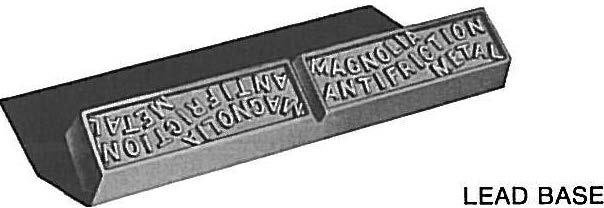
Magnolia
Anti-Friction Metal
Meets all requirements for general use. Offers good resistance to compression and has the lowest coefficient of friction of any known bearing metal … 1/3 that of genuine babbitt. ls graphite treated and largely self-lubricated.
Typical Applications:
Line shafting, electric motors 10 to 250 hp, winches, pumps, propeller shafts, cement mills, and general machinery.
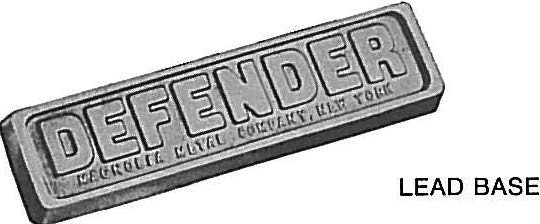
Defender
Bearing Metal
This is an effective lead-base substitute for Adamant. Defender metal will give excellent serv\ce under all shock loads with the possible exception of the bearings of some Diesel engines. It has better antifriction qualities than Adamant but must be poured with care, because Defender does not bond to the shell as easily as Adamant.
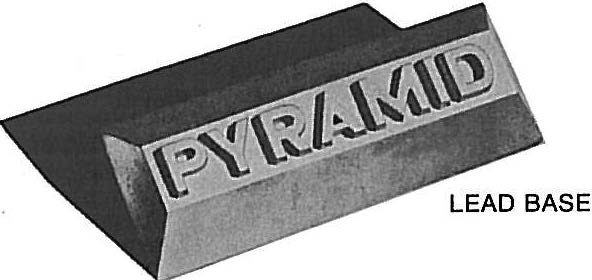
Pyramid
Bearing Metal
A chemically hardened lead-base alloy in which hardness, strength and high melting and softening points are combined. It has a lower coefficient of friction than Power. Laboratory and exhaustive field 1 tests show that Pyramid stands up equally as well as Power Bearing Metal under severe services such as paper mill calendar stacks and hydraulic turbines.
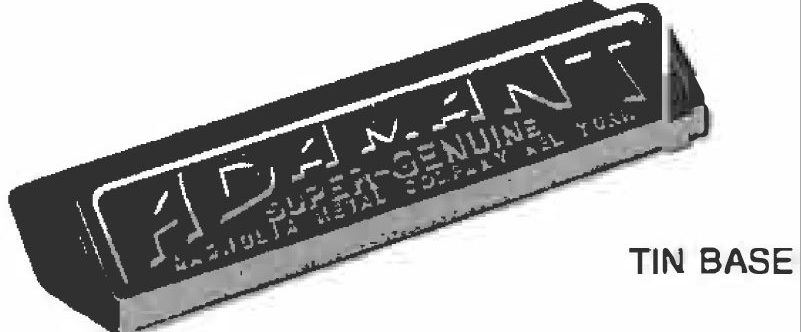
Adamant
Super-Genuine Babbitt
A “genuine” babbitt metal alloyed especially for malleability, strength and toughness. Will not crack or chip even when subjected to extremely severe shock loads. Easy to pour, conforms well to the shell.
Typical Applications:
Internal combustion engines, trap rock crushers, sifter machinery.
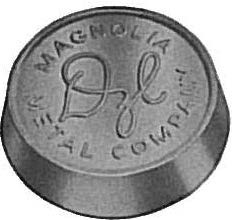
DZL Marine Nickel
Genuine Babbitt
MAXIMUM-DUTY, tin-base for combinations of excessive shock, heavy pressure and abnormal temperatures such as in Diesel connecting rods. One of the only babbitts ever made that will stand up in Diesel engine bearings. DZL also excels in rock crusher applications where toughness as well as imbedability are critical.
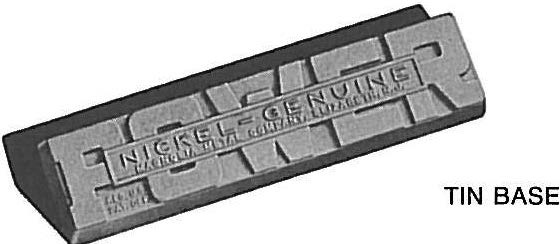
DZL Marine Nickel
Genuine Babbitt
Designed to withstand extremely heavy, sustained loads and high local heat conditions. It is alloyed for strength and hardness and will not squeeze out even under very heavy pressure.
Typical Applications:
Marine reciprocating engines, water turbines, paper mill calendar stacks, rolling mill machinery.
Physical Characteristics
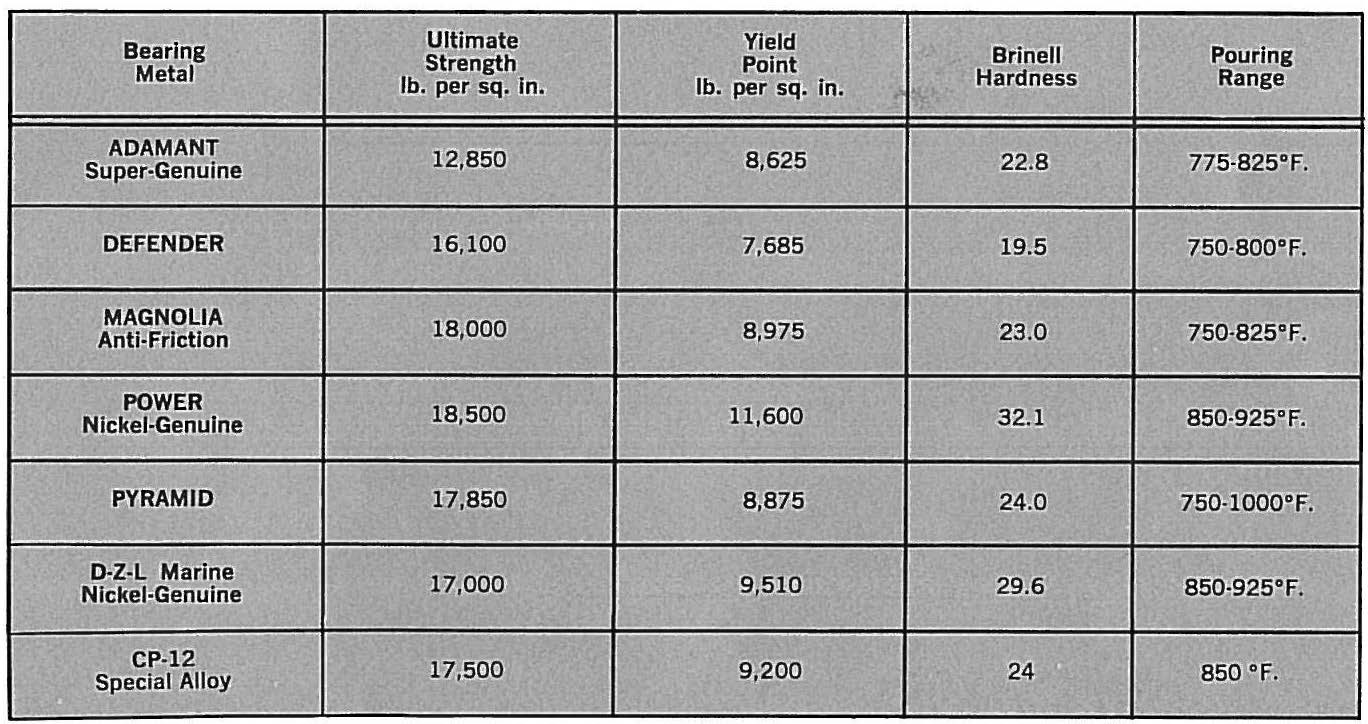
Magnolia Bearing Metals Give Longer Service Under Every Kind of Load
Magnolia Isotropic Bearing Bronze
STANDARD BAR STOCK
MAGNOLIA offers the largest size range of semifinished bronzes in both bar and bushing form in the industry today. Almost every possible combination of outside and inside diameters are available up to 26 ½” O.D. x 24″ I.D. thus permitting you to purchase the least amount of metal to produce your required parts. It is never necessary to purchase exceptionally heavy walled castings since Magnolia’s wide range of steel molds permits the fabrication of the size you need.
Standard stock-bars of Magnolia Isotropic Bronze are all 13″ long for immediate shipment. Many manufacturers attempt to cover a broad size range with comparatively few standard sizes in diameters over 5″ O.D. Many competitive brands are available only in excessively heavy walled bars. This increases your purchase weight and also increases the costly machine time required to finish machine in your shops. Compare available sizes before ordering.
As noted, stock sizes are 13″ long. The other standard length is 26 ¼” and both lengths are available in cored or solid bars from 1″ O.D. through 26 ½” O.D.
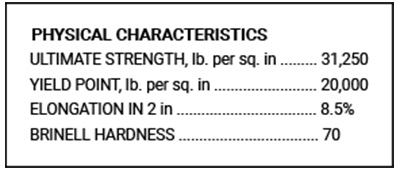
MAGNOLIA BRONZES wear longer than ordinary bronzes. Extended bearing life is an important part of the savings made when using MAGNOLIA alloys. This means less down time, fewer costly repair jobs, and little-lost production on important equipment.
MAGNOLIA Bronzes are unconditionally guaranteed to be free of all defects. This assures you of no blow-holes, no sand spots, no segregation, and most important, NO REJECTS.
MAGNOLIA ISOTROPIC BEARING BRONZE is cast in steel. This means you will never get a metal shot full of tiny diamond-hard points of sand that kill valuable tools and wear shafts. Only our casting method makes possible the dual heat· control (mold-heat and metal-heat) that assures perfect crystal control. The practical man who has broken different size gates off sand-castings knows the astonishing variation of crystal size. Under steel-cast conditions, uniform crystalline structures are always obtained. Our casting process is a tempering process. This is important because bronzes grow tougher with tempering.

Making & Maintaining Journal Bearings
To obtain maximum service from a lined bearing, several factors must be considered –
- Selection of proper bearing metal.
- Preparation of the shell and pouring of the bearing metal.
- The fit of the finished bearing.
- Lubrication.
The selection of the metal to be used for the lining depends on the type of load under which the bearing operates. Many bearings in use today are subject to uniform speed and moderate pressure, as in electric motors, line shafting, and general machinery. Magnolia Anti-Friction Metal is recommended for such services. When bearings are subjected to extremely heavy, sustained pressures, as is rolling mill machinery, a harder bearing metal is required such as Power Nickel-Genuine Babbitt or Pyramid Babbitt which will not squeeze out. Shock
When bearings are subjected to extremely heavy, sustained pressures, as is rolling mill machinery, a harder bearing metal is required such as Power Nickel-Genuine Babbitt or Pyramid Babbitt which will not squeeze out. Shock loads on the other hand would crack these harder babbitt metals. Therefore, bearings in internal combustion engines and trap rock crushers should be lined with a tough, yet malleable bearing metal like Adamant Super-Genuine Babbitt or Defender Babbitt. For installations subject to combinations of heat, weight and shock loads, D-Z-L Marine Nickel Genuine Babbitt is recommended. Most poured metal bearing linings have as a base one of two metals-lead or tin-alloyed with other elements such as antimony and copper. Tin-base babbitts have been considered superior to lead-base babbitts for most services because they are somewhat easier to pour, and a good bond between shell and lining is more readily obtained. However, Magnolia’s metallurgists have produced great improvements in lead-base bearing metals until today they stand on about an equal footing with tin-base metals. These improvements are most opportune. Tin is very high in price, therefore most users of babbitt prefer to switch to economical lead-base metals. If reasonable care is exercised in preparing the shells and in pouring, these new alloys will stand up under the most severe services. Shells should be well cleaned The first step in relining a bearing is to remove the old metal and thoroughly clean the shell. Old babbitt should be chipped or melted from the shell. If the shell is steel or iron, a blow-torch may be used. All traces of oil, dirt, scale, rust and old lining metal must be removed by burning, sand blasting, tumbling, wire brushing, and pickling or a combination
For installations subject to combinations of heat, weight and shock loads, D-Z-L Marine Nickel Genuine Babbitt is recommended.
Most poured metal bearing linings have as a base one of two metals-lead or tin-alloyed with other elements such as antimony and copper. Tin-base babbitts have been considered superior to lead-based babbitts for most services because they are somewhat easier to pour, and a good bond between shell and lining is more readily obtained. However, Magnolia’s metallurgists have produced great improvements in lead-based bearing metals until today they stand on about an equal footing with tin-base metals. These improvements are most opportune. Tin is very high in price, therefore most users of babbitt prefer to switch to economical lead-base metals. If reasonable care is exercised in preparing the shells and in pouring, these new alloys will stand up under the most severe services.
Shells should be well cleaned
The first step in relining a bearing is to remove the old metal and thoroughly clean the shell. Old babbitt should be chipped or melted from the shell. If the shell is steel or iron, a blow-torch may be used. All traces of oil, dirt, scale, rust and old lining metal must be removed by burning, sand blasting, tumbling, wire brushing, and pickling or a combination pouring, by bringing the bottom metal up to the top. Do not stir round and round. Always stir over and over.
Pouring
With all parts of the mold clean, thoroughly dry and preheated, pouring may begin. If a bottom-pour ladle is not used, dross should be skimmed from the molten metal and a ladle of the self-skimming type should be used. Each liner should be poured completely in one operation and a ladle sufficient to accomplish this should be used. Pouring too quickly will prevent air in the mold from escaping and will cause blow holes or seams in the lining. As cooling takes place, a certain amount of shrinkage occurs. Additional bearing metal should be added promptly as needed. Care should always be exercised to see that no moisture comes in contact with the molten metal. The steam formed will cause an explosion which will spray molten metal and may cause serious burns. Finishing the Bearing Excess
As cooling takes place, a certain amount of shrinkage occurs. Additional bearing metal should be added promptly as needed. Care should always be exercised to see that no moisture comes in contact with the molten metal. The steam formed will cause an explosion which will spray molten metal and may cause serious burns. Finishing the Bearing Excess
Finishing the Bearing Excess
Excess babbitt should be removed and all lubrication holes should be thoroughly cleaned. The bearing should be carefully fitted to the shaft. Best results are obtained by boring and scraping to a final fit using Prussian Blue Lo find the high spots. In order to provide thorough lubrication, oil grooves should be added. These distribute the oil properly and at the same time collect the oil, which would otherwise run out at the ends of the bearing, and return it to some point where it may be reused. The exact way in which these grooves are cut is of secondary importance, as long as they satisfactorily perform their function. It is obvious, however. that the grooves should not extend all the way to the edge of the bearing. Lubrication engineers claim that the best location for grooves is in the
Lubrication engineers claim that the best location for grooves is in the low-pressure areas near the entering side of the high-pressure area. Grooves should be shallow, with well-rounded edges. Sharp edges scrape the oil from the shaft. Avoid too many or too large grooves. They lend to break the oil film and reduce the effective bearing area. Split bearings should also be chamfered on each edge. Often, this is all that is needed in the case of high-speed bearings.
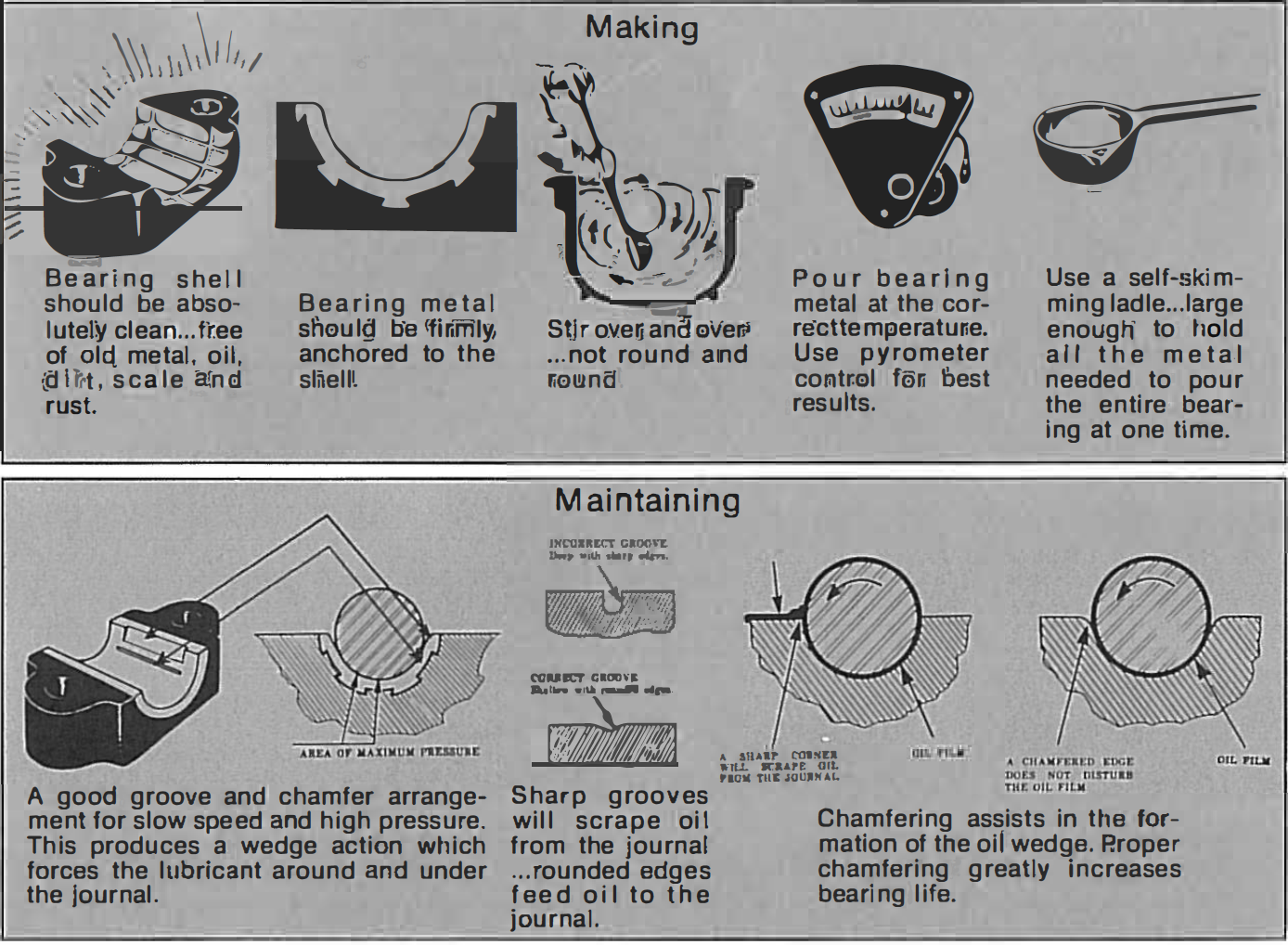
Magnolia Guarantees No Rejects
Magnolia Bronzes are guaranteed to be free from all defects. In Magnolia Bronze there are no blow-holes, no sand spots, no segregated elements, no flaws… no under-surface faults of any kind to cause rejection.
In accordance with industry practice, guarantee is limited to free placement of material returned. But why just “hope” to get a good casting? Magnolia’s quality control procedure has resulted in returns of less than 1/2 of 1% of all bronze shipped over the last 10 years. This standard of excellence combined with our special alloy and our unique casting process assures you of the best possible value in bearing bronze.
